*BONK* refers to the sound of hitting something with a baseball bat, deriving from a Doge meme in which a big shiba inu is hitting a small one and ordering it “BONK! Go to ______ jail!” The blank could be filled in with any word you like.
In order to discuss how the technologies of reproduction and encryption transform our imagination of cultural production, Lawrence Liu and Chen Pin-Hua are invited to develop five new pieces for this exhibition, focusing on the topics of meme, metadata and hash algorithm. *BONK* aims to create a humorous context like the Doge meme. The audiences are welcome to bonk their heads with the ideas behind the works. Through understanding the mechanisms, one could avoid being confused by the buzzwords.
Lawrence Liu, who is a cybersecurity engineer, sees memes as an encoding system. Encoding, for example by encrypting and compression, makes data being transmitted better and faster. Memes possess a tendency of self-replication since they are able to compress contexts. There is no need to defend the influence of memes, though they are not aiming at high resolution or quality and usually being spread in the form of “poor image” named by Hito Steyerl. Memes themselves function in the background. The artist builds a database of context with meme templates. New memes are constantly created by a program which fills new contents into the templates automatically.
American conceptual artist Joseph Kosuth used to question the meaning of “nothing” with dictionary definitions in six different languages. He claimed that “nothing” became “something” when one had to describe it with words. Same paradox appears in the digital world. Chen Ping-Hua’s Null looks for a way to describe “null” on blockchains. Different encoding systems and hash algorithms produce different versions of “null”, then which is the real “null”? Perhaps it is not even a problem to the operation of the digital world.
The two artists collaborate on The Original Copy and Binding. Chen has published his photographic works with “CC0 public domain” license, reserving no rights to his own photographs; in 2021, he created an NFT work entitled NF0, based on his previous CC0 practices. While institutions dedicated to preserving digital archives keep writing the metadata of their archives and entries, Chen erases all the metadata of his works when releasing them, in pursuance of the possibility to create more connections among the works and other entries. Each time we create a new document in software, we always get a blank one. Technically, every digital image comes from a blank, and every image can also be transformed into another one or back to a blank. What is presented in The Original Copy is the freedom to connect among digital images.
Binding extends the meaning of the blank in The Original Copy. It further describes the specific condition that a physical object interlink with an NFT. We invite the audience to bring over their own objects, wrap or band the objects on site and leave their wallet address. The whole process is linked to NFTs created by the artists for this exhibition.
Finally, The Cave by Chen Pin-Hua shows a reflection on the infrastructure of blockchains. Quoting from Plato’s “Allegory of the Cave”, the artist compares blockchains as the cave, and hash algorithm, the shadows projected on the walls. The basement of The Digital Arts Center, Taipei is built into a cave where computers installed there are executing encryption. The audience can not enter the cave but glance through a window on the floor.
Read the description of each works here.
「*BONK*」是棍棒敲擊物體的狀聲詞,來自一則以柴犬為原始主角的迷因,大隻柴犬用球棒敲打小隻柴犬的頭並喝令「蹦!不可以 ___ 」底線可自行帶入各種詞彙。
本展邀請劉家銘與陳斌華,圍繞著迷因、後設資料與雜湊演算法發展五件新作,探討複製與加密技術如何改變我們對於文化生產的想像。展覽希望能提供如同柴犬迷因般的詼諧情境,在當下被各種時髦術語環繞的資訊中,敲敲腦袋,透過作品了解技術實際的運作機制,才不被迷惑。
身為資安工程師的劉家銘,在《Meme Teller Machine》中將迷因視為一種編碼系統。編碼是使得資料更快速且妥善傳播的手段,具體方式如加密和壓縮,而迷因自我繁衍的傾向正因其具有壓縮情境的能力,儘管並不追求高像素或高畫質,且多以希朵.史戴爾所稱之「弱影像」形式流通,迷因的影響力卻不需要任何人為其辯護,迷因自己在日常背景中執行。劉家銘收集大量的迷因模板,建成情境描述的資料庫,並撰寫程式自動將新內容填入模板中,藉此不斷產生新的迷因。
美國觀念藝術家約瑟夫.科蘇斯曾以六種語言字典中對於「nothing」之定義,質疑當必須以語言描述「nothing」時,「nothing」是變成了「something」。在數位領域也有類似的弔詭,陳斌華的作品《Null》正是在探討區塊鏈上的「空」(Null)如何被表示。不同編碼方式與不同雜湊演算法下會產出不同的「空」,那麼,那一個才是真正的「空」?抑或這對於數位世界的運行並不構成問題。
《The Original Copy》與《Binding》是兩位藝術家共同發展的作品。陳斌華自 2016 年起以「CC0 公眾領域貢獻宣告」放棄著作財產權的方式發表攝影,他 2021 年的作品《NF0》在 CC0 的基礎上以 NFT 形式發行。當許多致力於數位典藏的機構積極為典藏品或條目加上後設資料,陳斌華在發表作品時卻將後設資料抹除,為使其產生更多連結的可能性。每當我們在軟體中打開一個新文件,面對的總是一塊空白,在技術上每個數位圖像都來自一片空白,每個圖像也能變成另一個圖像,或者回到起初的空白,《The Original Copy》所欲呈現的正是數位圖檔之間相互連結的自由。
《Binding》則拓展《The Original Copy》的那片空白,進一步描述實體物件與其 NFT 之間相互指涉且唯一的狀態。我們邀請觀眾攜帶自己的物品至展場,提供虛擬貨幣錢包地址,綁定實體物與藝術家為本次展覽發行的 NFT。
最後,陳斌華的裝置作品《洞穴》則是對於區塊鏈基礎建設的反思。作品名引用自柏拉圖洞穴寓言,他認為區塊鏈正如同那個洞穴,雜湊演算法則如投射在洞穴壁上的影子。臺北數位藝術中心地下室的將被打造成電腦執行加密運算的洞穴空間,觀眾無法實際進入,僅能透過一樓地面連通地下室的一小扇窗口窺看。
各件作品介紹詳見 DAC 網站。
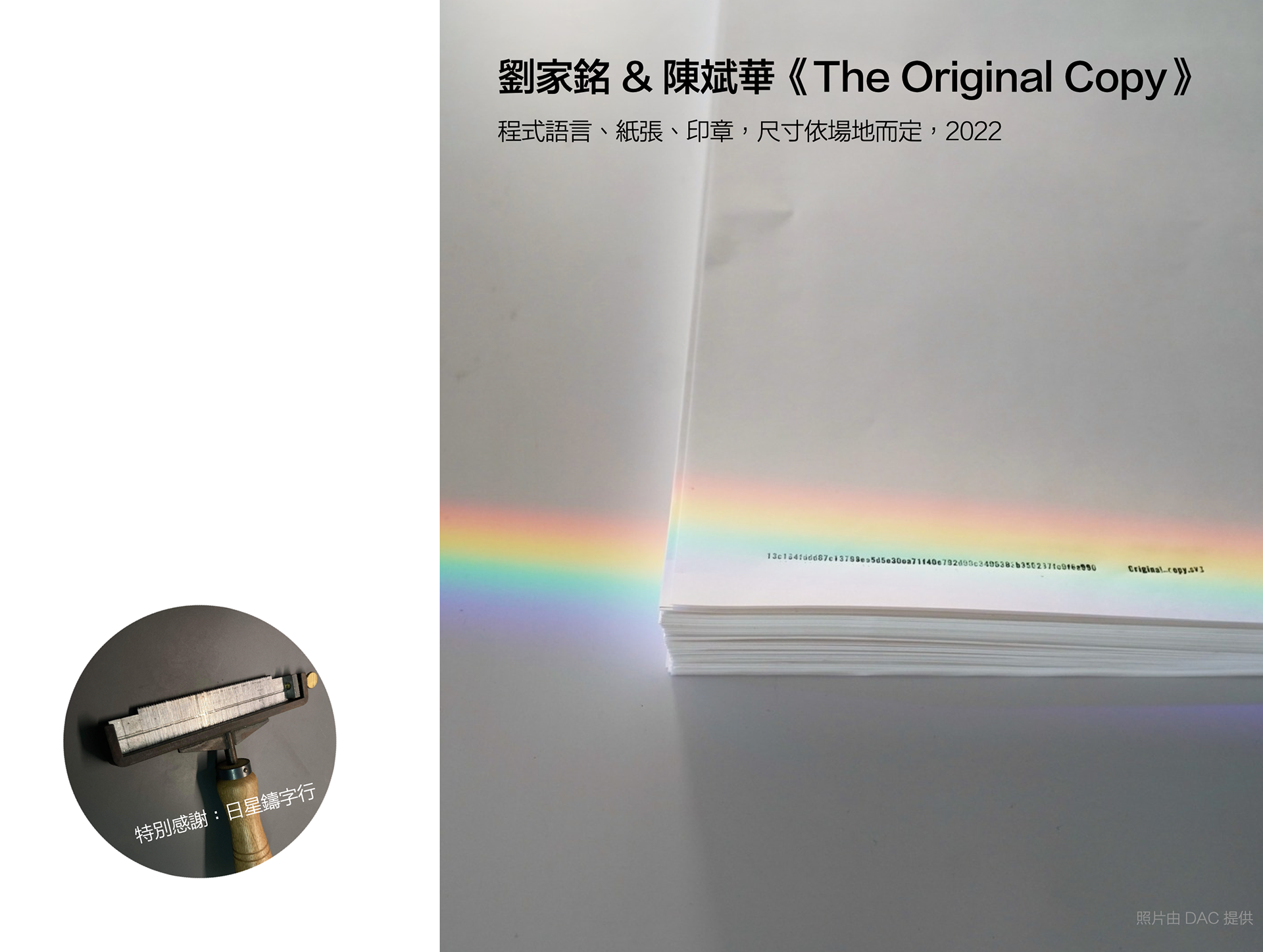

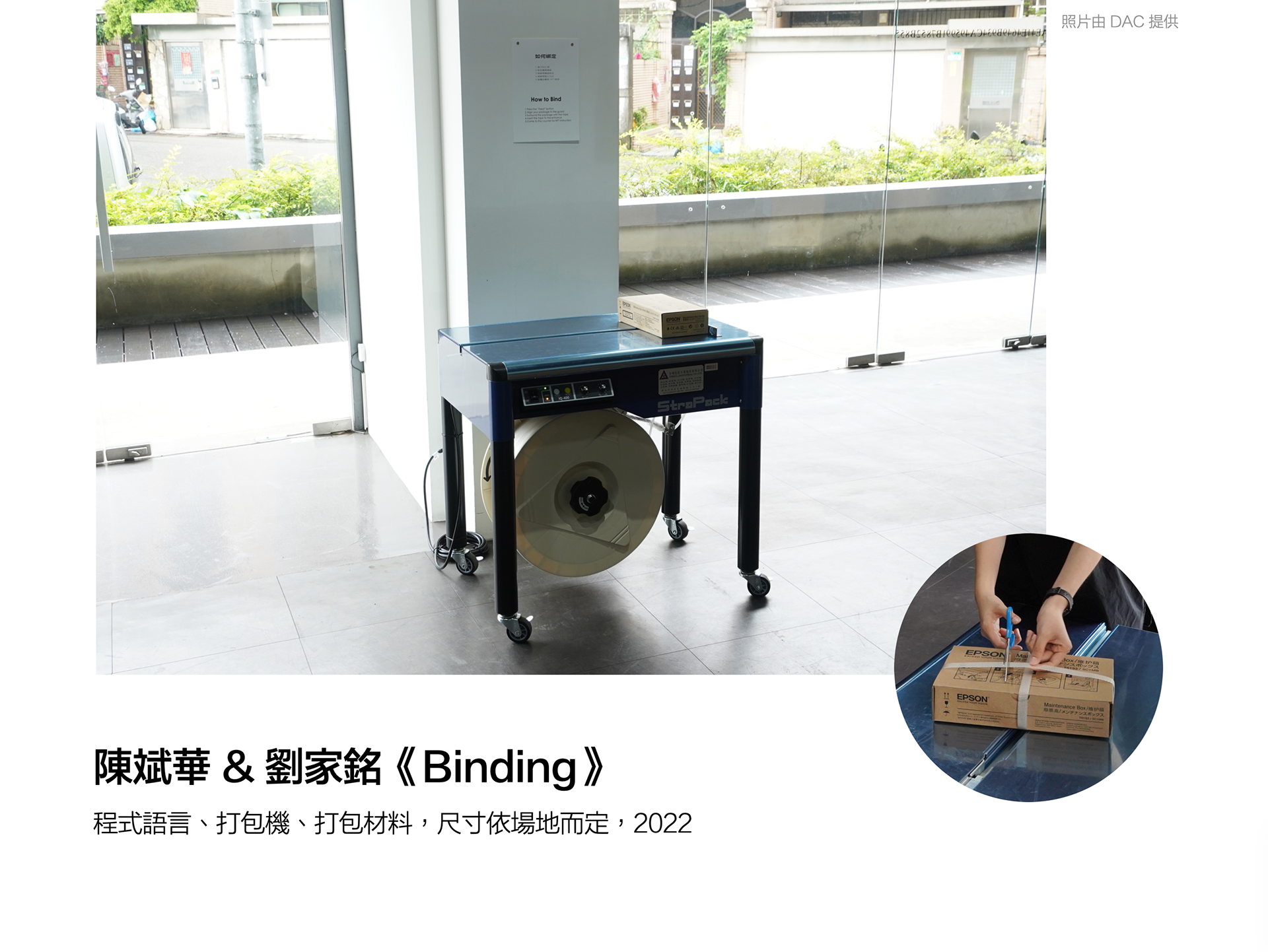
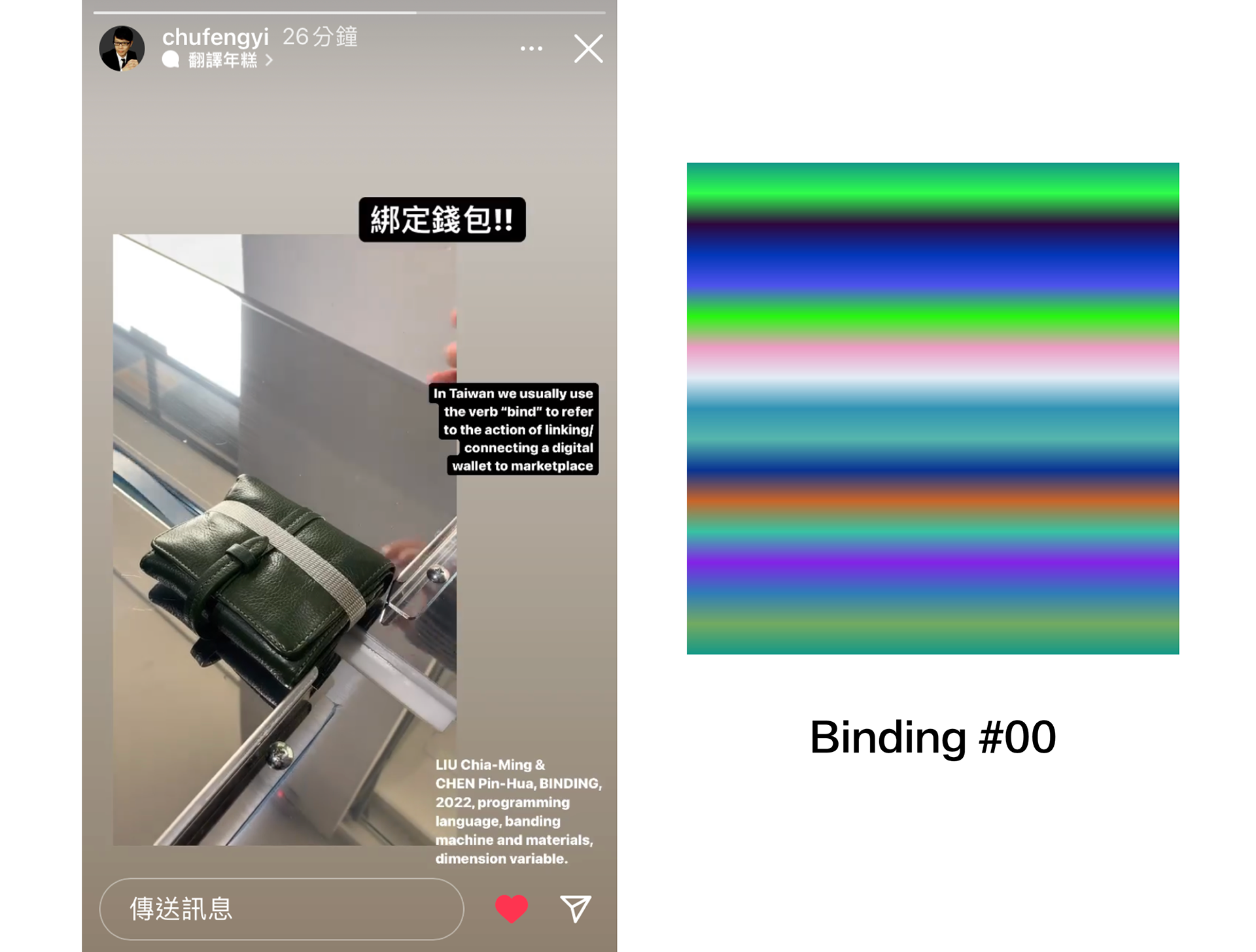
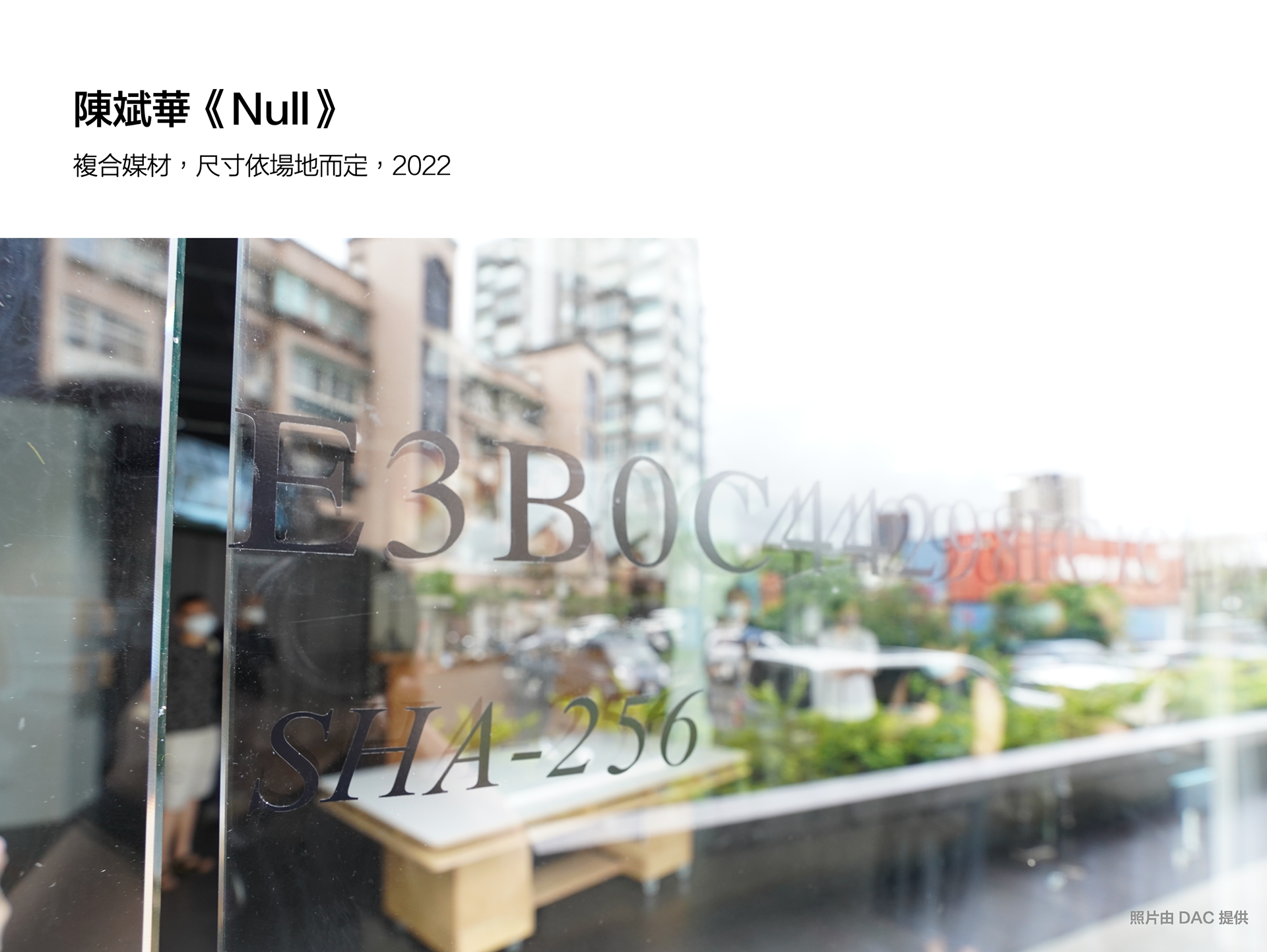

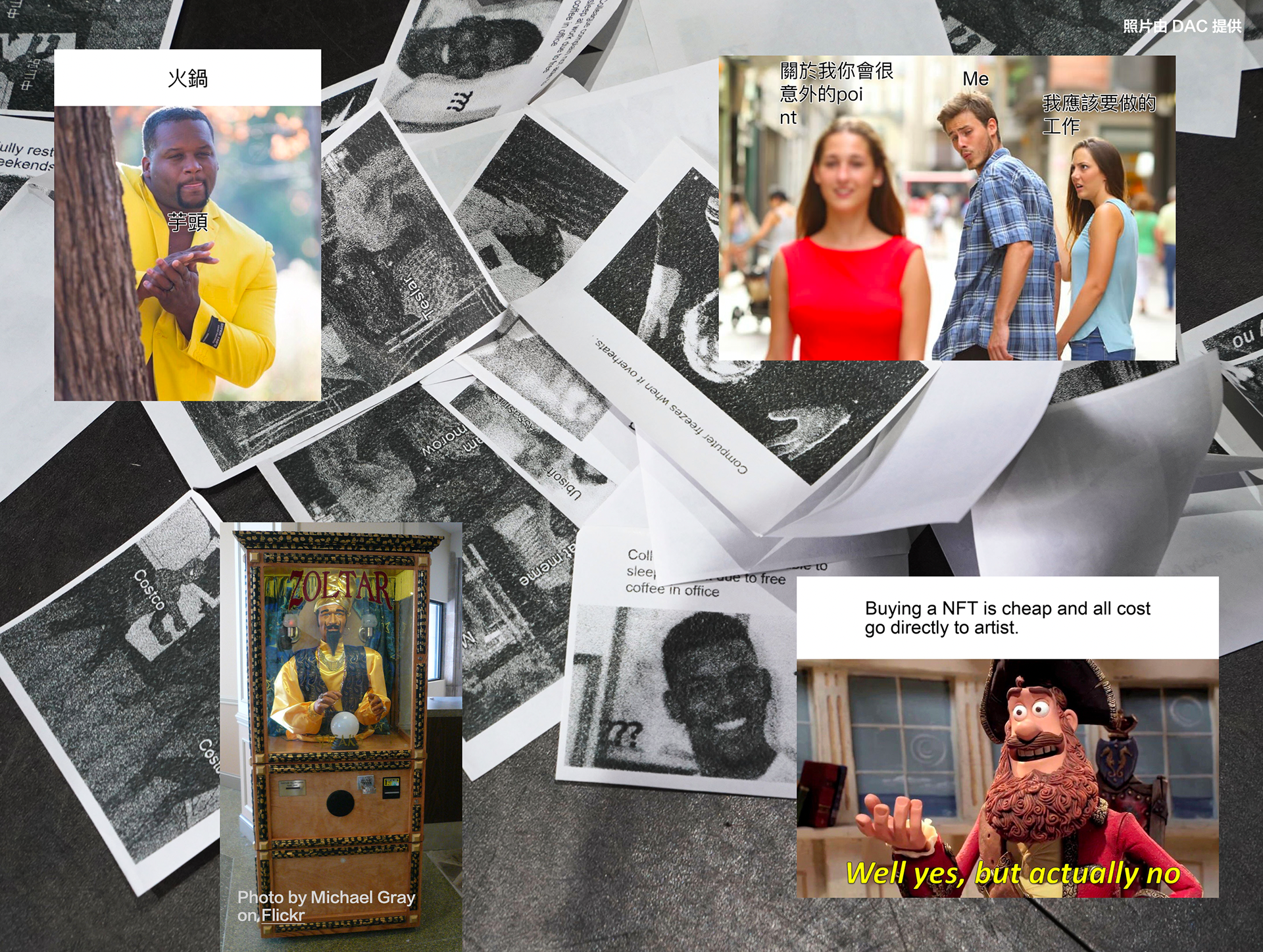

Organizer: Digital Art Center Taipei
Artist: Chen Pin-Hua, Lawrence Liu
Curator: Lee Chia-Lin
Visual Design: Lin Yi-Jou
Photographer: Yang Jyun Jie
On-site Production: Lin Zhe-Zhi, Lin Yu-Liang
Technical Support: Jerry Lin
Exhibition Coordinator&Public Event: Chang Ching-Yu
Artist: Chen Pin-Hua, Lawrence Liu
Curator: Lee Chia-Lin
Visual Design: Lin Yi-Jou
Photographer: Yang Jyun Jie
On-site Production: Lin Zhe-Zhi, Lin Yu-Liang
Technical Support: Jerry Lin
Exhibition Coordinator&Public Event: Chang Ching-Yu
Spacial thanks to Huang Po-Chih (Executive Director, DAC), Chen Hsiang-Wen (Artistic Director, DAC), Chu Feng-Yi (Speaker of the Artist Talk), Ri Xing Type Foundry, Yang Chen-Hao